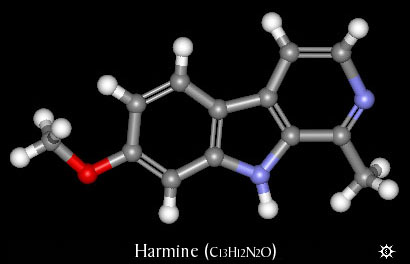Bignamini Aldo Alberto
Ciccone Laura
Ayahuasca : the secret potential of Harmine
Introduction
In South and Central America, the native people within many tribes living in the Amazon rainforest have a long historical tradition of making and consuming a natural medicine called ayahuasca. It is harvested and prepared mainly from a wild growing vine, called Banisteriopsis Caapi. Often, but not always, leaves from trees named Chacruna or Chaliponga (Psychotria Viridis and Diplopterys Cabrerana) are added to the tea, or in some regions Jurema tree bark (of the Leguminosae family and Mimosa species).

CAAPI VINE GROWING IN THE AMAZON JUNGLE
Eduardo E. Schenberg, Federal University of Sao Paulo:
”There are enough available evidence that the active substances in ayahuasca, especially dimethyltryptamine and harmine, has the positive effect of preventing cancer cells in cultures used for cancer research, and that these substances affect the biochemical processes that are crucial to the treatment of cancer in-vitro as well as in-vivo. The reports available about people with experience from ayahuasca in the treatment of cancer should be taken seriously. The hypothesis is that the combination of beta-carboline alkaloids (e.g. Harmine) and dimethyltryptamine present in ayahuasca blocks the transportation of nutrients to tumours, lessens the dividing process of cancer cells, and changes the unbalanced mutation-causing metabolism in cancer cells.”

TREATMENT AYAHUASCA – ETHNOBOTANICAL MEDICINE AND NEURODEGENERATIVE DISEASES
Harmine

Harmine (7-methoxy-1-methyl-9H-pyrido[3, 4-b] indole) is a tricyclic beta-carboline alkaloid that was originally isolated from seeds of Peganum harmala in 1847. Harmine is widely distributed in nature, such as in various plants, marine creatures, insects, mammalians, human tissues and body fluids. Harmine have antimicrobial, antiplasmodial, antifungal, antioxidative, antitumor, antimutagenic, cytotoxic and hallucinogenic properties. Beta-carboline compounds act as inverse agonists at the benzodiazepine site of the gamma- aminobutyric acid type A receptors and have actions entirely opposite to those of the anxiolytic benzodiazepines. These compounds are also associated with the potentiation of monoaminergic pathways through inhibition of (MAO) A or B , blockade of reuptake sites and direct activation of monoamine receptors.
Overview of beta-carboline alkaloids
Alkaloids are natural products widely distributed in plants, beverages, well-cooked foods and tobacco smoke. Beta-carboline alkaloids have been reported as normal constituents of human tissues and body fluids. They exhibit variety of biochemical, psychopharmacological, and behavioural effects in animals and humans. Beta-carboline alkaloids exhibited a wide range of psychopharmacological effects by binding to benzodiazepine, imidazoline, serotonin and opiate receptors as well as MAO inhibition. Ingestion of ayahuasca (herbal preparation) containing harmine improved psychometric measures of panic and hopelessness in humans. Harmine is a very important natural product due to its interesting chemistry, pharmacological importance and therapeutic potentials such as antitumor, anti-HIV and other biological activities. Neurochemical and behavioral studies have shown that some beta-carboline alkaloids facilitate the dopaminergic transmission and interact with D1 and D2 dopaminergic receptors in the striatum. Most beta-carboline alkaloids are known to be strong inhibitors of which metabolizes catecholamine neurotransmitters. Harmine possesses antidepressant activity by interacting with MAO A and several cell-surface receptors, including serotonin receptor 2A (5-hydroxytrytamine receptor 2A, 5-HT2A).

Effect of harmine against microorganisms
The potential induction of a programmed cell death in Trypanosoma b. brucei by harmine was studied by measuring DNA fragmentation and changes in potential of mitochondrial membrane. Harmine inhibits protein biosynthesis, microtubule formation and disturbs membrane fluidity. Harmine has also shown to inhibit Trypanosoma cruzi, the aetiological agent for Chagas disease which is one of the most serious protozoan diseases in Latin America.
Effect of harmine on central nervous system
Behavioural and molecular effects of harmine in rats were investigated. Chronic administration of harmine increased brain-derived neurotrophic factor protein levels in rat hippocampus. Effect of harmine on animal behavior was assessed in the forced swimming and open-field tests, and the results showed harmine reduced immobility time and increased both climbing and swimming time of rats, compared to saline group. Harmine at a higher dose level also increased brain-derived neurotrophic factor protein levels in the rat hippocampus. Effects of harmine on apomorphine-induced pecking behavior in chicks were also investigated. Harmine significantly decreased the pecking behavior induced by apomorphine. Besides, harmine showed beneficial effects on naloxone-precipitated morphine withdrawal syndrome in morphine-dependent rats. Harmine can stimulate the central nervous system by inhibiting the metabolism of amine neurotransmitters or by direct interaction with specific receptors. Effects of harmine on hyperhomocysteinemia on expression of DYRK1A were investigated and the results showed that it abolished with harmine treatment. Harmine has the ability to stimulate dopamine release, justifying its uses in the treatment of brain disorder.
Effect of harmine on enzyme systems
Harmine is a potent inhibitor of DYRK1A, a kinase implicated in Down syndrome. Harmine inhibits DYRK1A substrate phosphorylation more potently than it inhibits tyrosine autophosphorylation, providing an evidence for a role of DYRK1A in the regulation of neurite formation. Harmine, an inhibitor of the forkhead box class O (FoxO) kinase DYRK1A, stimulated FoxO nuclear accumulation and DNA binding activity. Harmine also stimulated ecdysone 662
20-monooxygenase activity as compared to the control.

Effect of harmine against cancer
The cytotoxicity of harmine was studied using filter paper disc technique and the results showed that complexation of metal with harmine reduced metalic toxicity. Cytotoxic and genotoxic effects of harmine were investigated in V79 Chinese hamster lung fibroblasts in vitro using single- cell gel assay, also known as Comet assay, and the results showed that harmine increased aberrant cell frequency and induced DNA damage as evidenced by the Comet assay. Effects of harmine on yeast Saccharomyces cerevisiae were investigated to verify putative genotoxicity, mutagenicity and recombinogenicity. Harmine is capable of inducing DNA single or double strand breaks. The cytotoxicity of harmine was monitored by the brine shrimp lethality test and microdilution method was used to determine minimum inhibitory concentration and minimum bactericidal concentration of the compounds. Harmine showed cytotoxicity in the tested model. The role of harmine in apoptosis of B16F-10 cells was investigated. Harmine activates both intrinsic and extrinsic pathways of apoptosis and regulates some transcription factors and pro-inflammatory cytokines. The in vivo anti-angiogenic activity of harmine was studied using B16F-10 melanoma cells in C57BL/6 mice. Harmine decreased tumour directed capillary formation, justifying its angiogenic inhibitory potential. Harmine inhibited breast cancer resistance protein (BCRP) in a BCRP overexpressing breast cancer cell line MDA-MB-231. Toxicity of harmine was evaluated by cytochalasin-B blocked micronucleus assay and the viability/colony formation assay with four different human cells, including non-transformed CCD18Lu and transformed HeLa, C33A and SW480 cells. Harmine showed inhibitory effects on cell proliferation against all human carcinoma cells. In cytotoxicity assays, harmine exhibited a strong inhibitory effect on the growth and proliferation of carcinoma cells whereas it had no significant effect on quiescent fibroblasts. Evaluation on harmine cytotoxicity toward proliferation and differentiation of HL60 cells, alone or in combination with ATRA and G-CSF, showed that harmine reduced proliferation in a dose and time dependent manner. In another study, harmine showed cytotoxicity against HL60 and K562 cell lines.
Effect of harmine on bone system
The investigation on effect of harmine on RAW264.7 cells showed that it inhibited multinucleated osteoclast formation induced by receptor activator of nuclear factor-kappa B ligand RANKL. Furthermore, harmine prevented RANKL- induced bone resorption in both cell and bone tissue cultures.
Effect of harmine against inflamation
Anti-inflammatory activity of harmine were achieved through suppression of tumor necrosis factor (TNF)- alpha and nitric oxide production in lipopolysaccharide lipopolysaccharide-stimulated mouse RAW264 and human THP-1 cells. Harmine showed stronger TNF-alpha suppressive activities than reference polyphenol and butein in RAW264 cells. Harmine was also found to suppress interleukin-6 production in RAW264 cells.
Conclusions
The use of harmine as a multi-purpose traditional medicine has been translated into several commercial applications and it is a highly valued phytoconstituent in the natural health, food and research area. Harmine has many traditional medicinal uses and pharmacological activity such as antimicrobial, anti-HIV and antiparasitic properties. Scientific studies conducted and verified many of the traditional uses including anti-inflammatory, anti- microbial, anti-parasitic and anti-cancer effects.

Recent pharmacological developments in β-carboline alkaloid harmine
Developments in harmine pharmacology--implications for ayahuasca use and drug-dependence treatment
A review on medicinal importance, pharmacological activity and bioanalytical aspects of beta-carboline alkaloid Harmine